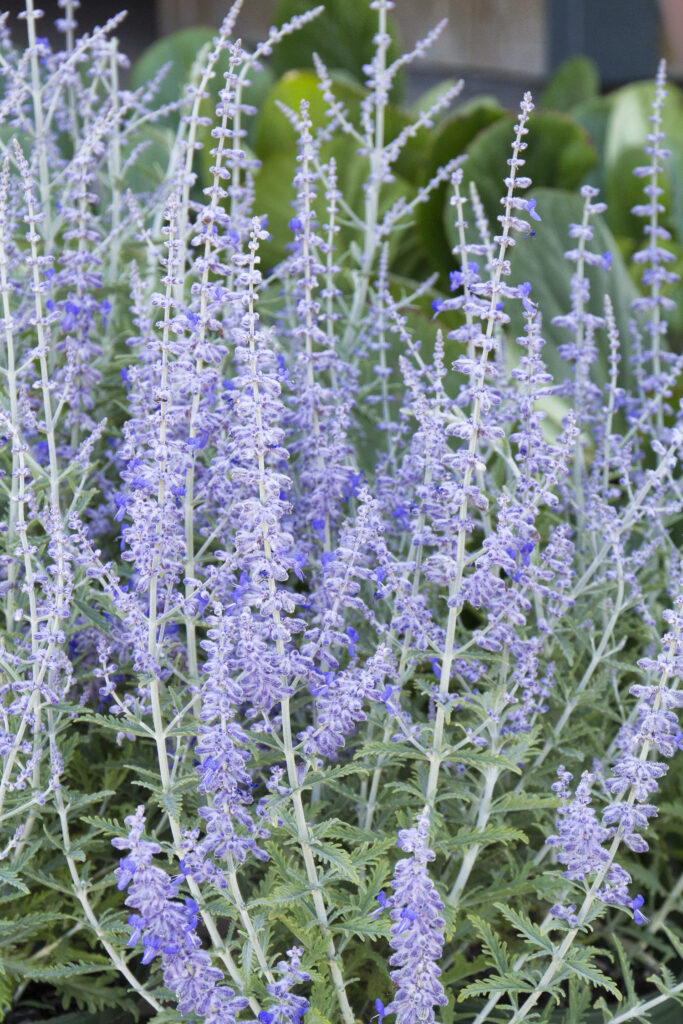
How to Grow Russian Sage
by Ken Lain, the mountain gardener
Russian Sage is a Watters preferred perennial for the compact form that doesn’t flop over in the landscape like others. The spikey blue flowers bloom summer through fall with aromatic foliage detestable to all animals. Simply stunning at the edge of dry stream beds mixed with wildflowers.

Plant en masse to add a wonderful drift of color to the landscape. It’s a delightful alternative to lavender in cottage gardens or along fence lines of pickets or iron. Shows well in traditional parterres or hedge-bound planters. Casual character is equally suited for wild gardens amidst rocky outcroppings or landscape boulders. Outstanding at edges of dry stream beds with wildflowers. Excellent container specimen in clay pots.
This hardy, heat, and drought-tolerant selection is an improved, sturdy, compact form that does not flop over in the landscape! Lavender-blue flower sprays enhance its aromatic, deer-resistant foliage. A colorful, easy-care choice for an accent, border, or mass planting.
Botanical Name: Perovskia atriplicifolia
Common Name: Russian Sage
Plant Type: Perennial flowering shrub
Mature Size: 4′ foot
Sun Exposure: Full sun
Soil Type: Sandy, clay
Soil pH: 7 to 9
Bloom Time: Summer
Flower Color: Blue
Hardiness Zones: 5-9
How to Grow Russian Sage
Russian Sage is a tough plant that needs little care. Being tall, it does often require support (either staking or a peony ring). If grown in masses, they more or less support one another. But the primary care concern with these plants is pruning, which is optional.
As a mint family member, the Russian Sage spreads by runners and needs to be monitored to remove them from places you don’t want it to spread. Pull up suckers in the early spring. Divide the plants every four to six years to refresh them.
Russian Sage has fragrant foliage and attracts hummingbirds, honey bees, and butterflies. Like many aromatic plants, they are also deer-resistant, and rabbits are unlikely to eat them. Its fine texture makes Russian Sage a good choice if you’re seeking contrast with plants exhibiting a coarser texture.
Light
For best results and blooms, plant Russian Sage in 6+ hours of full sun.
Soil
This bush thrives in well-drained soil but tolerates clay. They prefer alkaline soils of pH 7 and greater but handle a wide range of soil pH.
How to plant
1.Dig hole 2-3 times the width of the container but the same depth.
2. Score the root ball sides and bottom with a utility knife or pruners and place them in the planting hole.
3. Blend Watters Premium Mulch into the native soil at 1 part mulch with two parts soil dug from the hole and pack firmly around the roots.
4. Sprinkle 7-4-4 All Purpose Plant Food around the planting area.
5. Prevent ‘Transplant Shock’ by adding Watters “Root & Grow” to your water at 2-week cycles for the first 2 months.
6. Use remaining Watters Mulch inside the tree well as a top dressing. This will keep weeds down, insulate roots from heat and cold, and keep the roots moist.
How to Water
Always water your newly planted grass thoroughly after transplanting. The roots require plenty of moisture to recover from the stress of the transplant. Failing to water your Russian Sage could stunt its growth.
Ensure that you keep the soil uniformly moist. Push your finger an inch into the soil. If it feels damp, then your grass is fine. However, if it’s dry, it means that the roots aren’t getting the moisture they need.
Stop all irrigation and water to this plant after the first full growing season.
How to Feed for Showy Russian Sage
During the first year after planting, fertilize Russian Sage in the early spring, summer, and fall with 7-4-4 All Purpose Plant Food. It can take up to 3-years for a small Russian Sage to establish itself and bloom properly.
Varieties of Russian Sage
Perovskia “Filagran” has finely-cut leaves and an airy appearance.
Perovskia “Longin” is more rigidly upright and narrower and has slightly larger leaves.
Perovskia “Little Spire” is a dwarf variety that matures at about 1.5 to 2 feet tall, with a similar spread.
Pruning
Some gardeners choose to prune Russian Sage annually. The argument for pruning is that the plant will grow to be bushier due to this care. At the very least, it’s a good idea to cut off any dead branches to keep this perennial tidy. The normal time to prune Russian Sage is February through March.
One reason spring is the best time to prune, as opposed to trimming in fall, is leaving the silver branches adds interest to the winter landscape. Another is that if you trim in the fall and don’t get a hard freeze, the plant could start producing new growth. At that point, a hard freeze could kill the new growth. There are two basic trimming strategies: one is to prune down to within a few inches of ground level in early spring and just be done with it. Another approach is to wait until mid-spring and allow the plant stems to start to fill in with leaves. You’ll identify the dead stems this way as the ones that aren’t filling in, and you can proceed to cut them off. Then, make a judgment regarding the remaining branches. For example, if you want to start out with 1-foot tall stems, make your cut at 1 foot. The taller the plant starts out in spring, the taller it will end up in fall.
